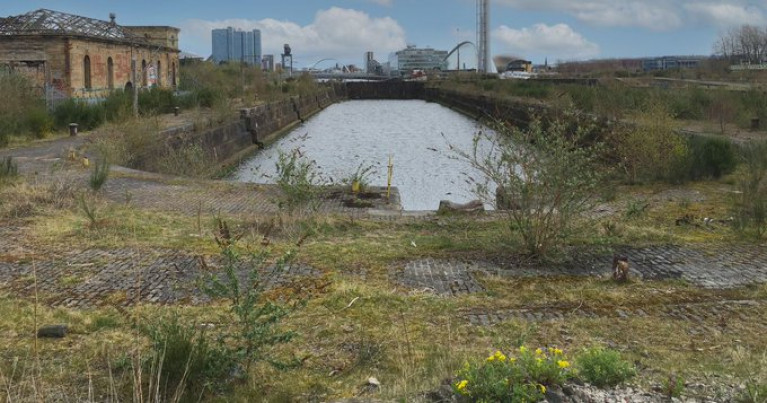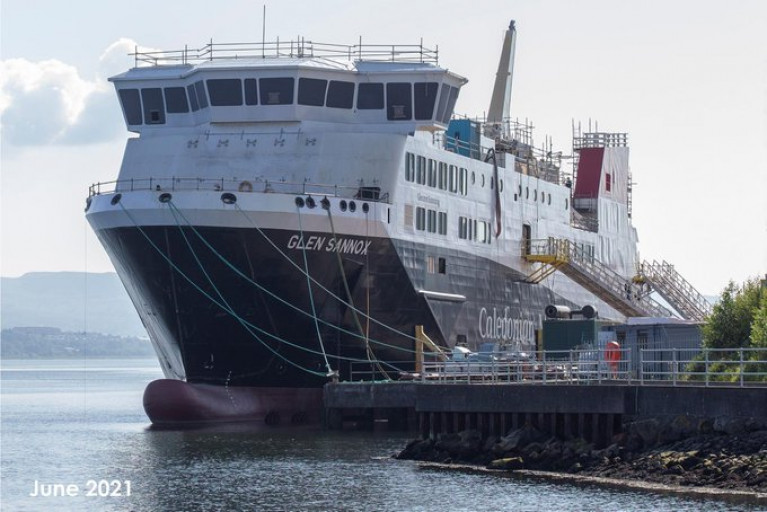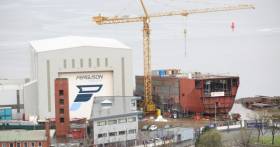Displaying items by tag: Clyde shipyard
Environmentally Friendly Scots Fiasco Ferry Cannot Initially Run 'Green' Due to Fault
One of the Scottish ferries at the centre of a shipyard ferry fiasco could see it lose its green credentials following a new fault.
The Ferguson Marine shipyard which was nationalised in 2019, has confirmed that further issues with the first of two newbuild ferries, the MV Glen Sannox means it will not initially run on liquefied natural gas (LNG).
Instead the 102m ferry for the Ardrossan-Brodick (Isle of Arran) route will be operating on a diesel, single fuel system for at least the first nine months of its service on the Clyde.
Following this period, the twin funnel ferry may then have to be taken out of service to test its LNG system.
Graham Simpson, the Scottish Conservative shadow transport minister said: “This revelation just adds to the shambles around the building of this vessel which was supposed to be climate friendly."
Both Glen Sannox and the second newbuilding (Hull 802) were hailed as a step towards a greener future for Caledonian MacBrayne (CalMac) Scotland's state owned ferry fleet, as they were to be the first ships built in the UK capable of running off LNG and marine gas oil.
The twin duel-fuel powered ferries were seen as significantly cleaner in addition they would help to reduce emissions levels to meet ambitious Scottish Government targets.
More the HeraldScotland reports on this development at the Port Glasgow shipyard.
Historic Clyde Shipyard At Govan Docks to Repair Ships Again
On the River Clyde a £500,000 scheme was announced to re-open the A-listed derelict Govan Graving Dock, just west of the Glasgow Science Centre at Pacific Quay on the river's south side.
According to The Scotsman, the company behind the plans, Govan Drydock Ltd, said it was committed to returning the site to being a “fully operational ship repair and maintenance facility” by the end of this year.
The company hopes to win work for both commercial shipping and historic vessels and said it already had been granted a licence to operate Govan graving dock number one, which is 551ft (169m) long, 72ft (22m) wide and 22ft (6.7m) deep.
Restoration work will include on the entrance gates, block repairs, dive surveys, and cleaning.
Re-opening the docks will need planning permission from Glasgow City Council because of the change of use from their current derelict status.
The docks were built of granite in the late 19th century by the Clyde Navigation Trust, part of which was hand carved, when they could accommodate some of the largest ships in the world.
They were used for winter overhauls, repairs and refits of Clyde steamers (see TS Queen Mary) until their closure in 1987, since when they have remained derelict.
Further reading here on the story to revive the historic dockyard.
Delays of up to a further five months to the completion of two long-awaited CalMac ferries were announced yesterday by shipyard Ferguson Marine, writes The Scotsman.
The latest setback was blamed on a shortage of skilled workers and Covid restrictions at the Scottish Government-owned shipyard in Port Glasgow.
MV Glen Sannox, being built for the main Isle of Arran route between Ardrossan and Brodick, is now due to be finished between July and September next year, compared to the previous estimate provided to MSPs last August of between April and June next year – three months behind.
Its unnamed sister ferry, codenamed hull 802, earmarked for the Skye-Harris-North Uist route, is now scheduled for completion between April and July 2023, compared to between December 2022 and February 2023 – up to five months behind.
A spokesperson for Ferguson Marine (Port Glasgow) said: “The Covid-19 pandemic caused six months of disruption in 2020 and productivity has continued to be impacted due to a further shutdown in January 2021 and the introduction of additional safety measures.
Much more to read here from the Clydeside yard.
Scottish Government Rejects Offer of Stake in Clyde Shipyard
Jim McColl has failed to convince the Scottish Government to take a stake in the last commercial shipyard on the Clyde.
The near-billionaire, The Herald writes, was understood to be ready to take a multi-million-pound “hit” on his investment at Ferguson Marine in Port Glasgow.
And this week he convinced Labour and SNP local to back his scheme in the hope of securing 350 jobs after their current contracts to make ferries ran in to cost over-runs and contractual disputes.
Ministers consider nationalising shipyard owned by billionaire adviser to Nicola Sturgeon (click here for more).
The Herald understands Mr McColl and his Clyde Blowers Capital or CBC felt they had legal advice that assuaged concerns by civil servants over an equity partnership.
However, a Scottish Government spokesman said: “We share the determination to ensure a strong, long term future for Fergusons.
For more click here including a related article on the yard which predicts a loss of £44m on a pair of newbuild dual-fuel ferries for CalMac.
































































